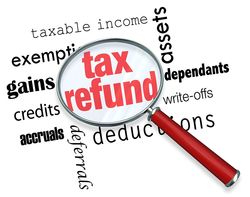There are several good reasons to choose direct deposit as a way to receive your tax refund from the IRS.
First of all, it’s faster and more convenient. Using digital resources to file electronically and selecting an electronic way to receive your refund can cut 2 to 3 weeks off the time of processing and delivering your refund check.
 With direct deposit, there is less worry about when a check will arrive, when you’ll have time to deposit it and how long it will take to clear through your bank’s approval process in order for you to use the money. You also won’t have to be concerned about the possibility of your check being stolen or “lost” in the mail.
With direct deposit, there is less worry about when a check will arrive, when you’ll have time to deposit it and how long it will take to clear through your bank’s approval process in order for you to use the money. You also won’t have to be concerned about the possibility of your check being stolen or “lost” in the mail.
It is relatively easy to file for direct deposit of your refund. The only issue some taxpayers face is entering the correct bank account and routing number on the request form. So, when filling out the direct deposit authorization form, check those numbers carefully.
Another helpful option associated with direct deposit is you will be able to split the deposit of your tax refund into several financial accounts. It does require filling out another form, FORM 8888 Allocation of Refund, to provide more account details. You may split your electronic tax refund between checking, savings and certain retirement, health and education accounts. You are limited to using up to three of your and/or your spouse’s personal accounts (if filing jointly).
Some banks require the names of both spouses to be on the selected bank account(s) IF the tax refund is from a joint return. So, you may want to contact your banker to confirm those details. You may not split deposits into accounts owned by others who are not listed as a taxpayer on tax return. For example, you may not automatically designate using part of your refund to pay your tax preparer.
Additionally, the IRS has new rules that will not allow more than three electronic direct deposit refunds into a single financial account or pre-paid debit card. Taxpayers who exceed the limit will receive an IRS notice and a paper refund.
Find out more about direct deposit and split refund options in the IRS Publication 17. Please contact us if you have any questions.
 is now
is now 
